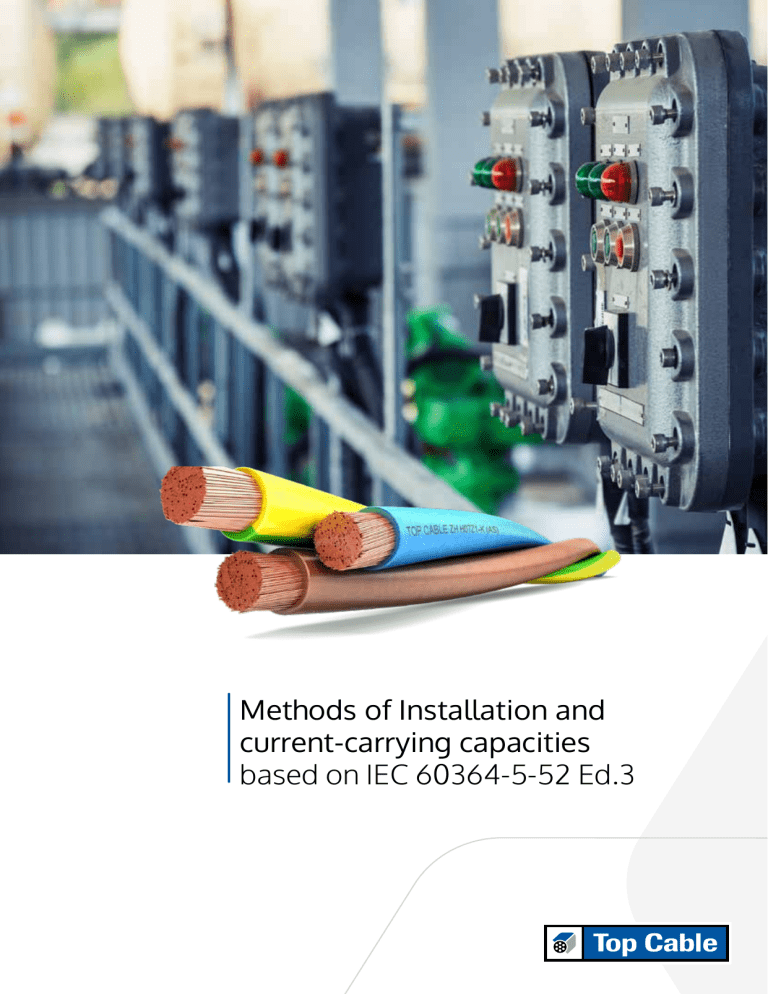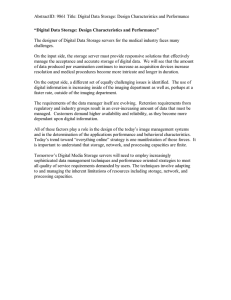
Methods of Installation and current-carrying capacities based on IEC 60364-5-52 Ed.3 Top Cable Centro Tel. 91 895 52 00 tcmadrid@topcable.com Top Cable Levante Tel. 961261515 tcvalencia@topcable.com Tel. +31 070 311 73 67 tcholland@topcable.com Denmark & Norway Scankab cable a/s Tel. +45 702 034 55 scankab@scankab.dk Top Cable Singapore Tel. +65 626 211 61 tcsingapore@topcable.com Top Cable Chile Tel. +56 2 947 80 00 tcchile@topcable.com http://www.topcable.com/topmatic/ The fastest tool to calculate electric cable size Methods of installation and current-carrying capacities based on IEC 60364-5-52 Ed.3 SUMMARY page Methods of installation: Table A.52.3 Examples of methods of installation providing instructions for obtaining current-carrying capacity 3-9 Current-carrying capacities: Table B.52.1 Installation reference methods forming basis of tabulated current-carrying capacities 10 Table B.52.2 Current-carrying capacities in amperes for methods of installation in Table B.52.1 : - PVC insulation/two loaded conductors, copper or aluminium - Conductor temperature: 70 °C, ambient temperature: 30 °C in air, 20 °C in ground 11 Table B.52.3 Current-carrying capacities in amperes for methods of installation in Table B.52.1 : - XLPE or EPR insulation, two loaded conductors/copper or aluminium - Conductor temperature: 90 °C, ambient temperature: 30 °C in air, 20 °C in ground 12 Table B.52.4 Current-carrying capacities in amperes for methods of installation in Table B.52.1: - PVC insulation, three loaded conductors/copper or aluminium - Conductor temperature: 70 °C, ambient temperature: 30 °C in air, 20 °C in ground 13 Table B.52.5 Current-carrying capacities in amperes for methods of installation in Table B.52.1 : - XLPE or EPR insulation, three loaded conductors/copper or aluminium - Conductor temperature: 90 °C, ambient temperature: 30 °C in air, 20 °C in ground 14 Table B.52.6 Current-carrying capacities in amperes for installation method C of Table B.52.1 : - Mineral insulation, copper conductors and sheath - PVC covered or bare exposed to touch - Metallic sheath temperature: 70 °C, reference ambient temperature: 30 °C 15 Table B.52.7 Current-carrying capacities in amperes for installation method C of Table B.52.1 : - Mineral insulation, copper conductors and sheath - Bare cable not exposed to touch and not in contact with combustible material - Metallic sheath temperature: 105 °C, reference ambient temperature: 30 °C 16 Table B.52.8 Current-carrying capacities in amperes for installation methods E, F and G of Table B.52.1 : - Mineral insulation, copper conductors and sheath/PVC covered or bare exposed to touch - Metallic sheath temperature: 70 °C, reference ambient temperature: 30 °C 17 Table B.52.9 Current-carrying capacities in amperes for installation methods E, F and G of Table B.52.1 : - Mineral insulation, copper conductors and sheath – Bare cable not exposed to touch - Metallic sheath temperature: 105 °C, reference ambient temperature: 30 °C 18 Table B.52.10 Current-carrying capacities in amperes for installation methods E, F and G of Table B.52.1 : - PVC insulation, copper conductors - Conductor temperature: 70 °C, reference ambient temperature: 30 °C 19 Table B.52.11 Current-carrying capacities in amperes for installation methods E, F and G of Table B.52.1 : - PVC insulation, aluminium conductors - Conductor temperature: 70 °C, reference ambient temperature: 30 °C 20 1 2 Methods of installation and current-carrying capacities based on IEC 60364-5-52 Ed.3 SUMMARY page Table B.52.12 Current-carrying capacities in amperes for installation methods E, F and G of Table B.52.1 : - XLPE or EPR insulation, copper conductors - Conductor temperature: 90 °C, reference ambient temperature: 30 °C 21 Table B.52.13 Current-carrying capacities in amperes for installation methods E, F and G of Table B.52.1 : - XLPE or EPR insulation. aluminium conductors - Conductor temperature: 90 °C, reference ambient temperature: 30 °C 22 Table B.52.14 Correction factor for ambient air temperatures other than 30 °C to be applied to the current-carrying capacities for cables in the air 23 Table B.52.15 Correction factors for ambient ground temperatures other than 20 °C to be applied to the current-carrying capacities for cables in ducts in the ground 24 Table B.52.17 Reduction factors for one circuit or one multi-core cable or for a group of more than one circuit, or more than one multi-core cable, to be used with current-carrying capacities of Tables B.52.2 to B.52.13 25 Table B.52.18 Reduction factors for more than one circuit, cables laid directly in the ground - Installation method D2 in Tables B.52.2 to B.52.5 - Single-core or multi-core cables 26 Table B.52.19 Reduction factors for more than one circuit, cables laid in ducts in the ground - Installation method D1 in Tables B.52.2 to B.52.5 27-28 METHODS OF INSTALLATION 3 METHODS OF INSTALLATION 4 METHODS OF INSTALLATION 5 METHODS OF INSTALLATION 6 METHODS OF INSTALLATION 7 METHODS OF INSTALLATION 8 METHODS OF INSTALLATION 9 CURRENT-CARRYING CAPACITIES 10 CURRENT-CARRYING CAPACITIES 11 CURRENT-CARRYING CAPACITIES 12 CURRENT-CARRYING CAPACITIES 13 CURRENT-CARRYING CAPACITIES 14 CURRENT-CARRYING CAPACITIES 15 CURRENT-CARRYING CAPACITIES 16 CURRENT-CARRYING CAPACITIES 17 CURRENT-CARRYING CAPACITIES 18 CURRENT-CARRYING CAPACITIES 19 CURRENT-CARRYING CAPACITIES 20 CURRENT-CARRYING CAPACITIES 21 CURRENT-CARRYING CAPACITIES 22 CURRENT-CARRYING CAPACITIES 23 CURRENT-CARRYING CAPACITIES 24 CURRENT-CARRYING CAPACITIES 25 CURRENT-CARRYING CAPACITIES 26 CURRENT-CARRYING CAPACITIES 27 CURRENT-CARRYING CAPACITIES 28 Methods of Installation and current-carrying capacities based on IEC 60364-5-52 Ed.3 sales@topcable.com www.topcable.com



